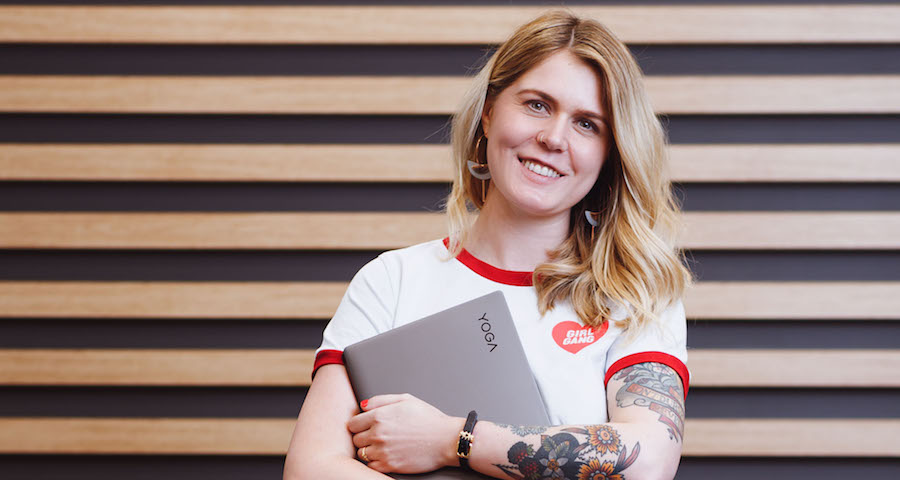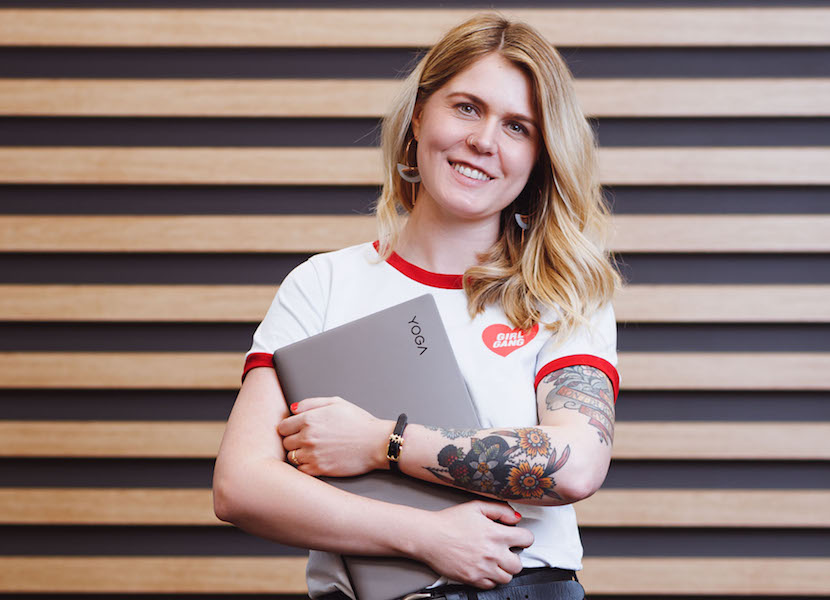Code Like A Girl CEO Ally Watson is on a mission to make the tech industry more inclusive
Image via Marie Claire
Words by Ella Bazzani Hockley
How one image laid the foundation for gender inequality in the tech industry.
It all started back in 1972 when software engineers decided to use a Playboy centrefold as a source for digital ‘bits’ (binary digits). In other words, the centrefold became a test image used to generate algorithms that would turn photos into encoded digital data.
The image was of Swedish model Lena Forsen. Lena’s image was used for research that laid the foundations for what would eventually become the JPEG, and 46 years later her image is still one of the most widely used in the world, particularly for coders. But her image was used without her knowledge or consent.
Now, decades later, a new documentary Losing Lena is raising questions about how inclusive the tech industry is. Developed for Creatable and Code Like a Girl by Clemenger BBDO Sydney, Finch, Facebook and Kamber, the documentary explores why removing Lena’s image will help more women feel welcome in tech.
Since its initial use by coders and software engineers, Lena’s image has become ubiquitous in tech circles, oftentimes as a blokey in-joke. Women in tech want to remove her image, so they can sit in their STEM (Science, Technology, Engineering, Mathematics) classes and feel included when learning about early JPEG processing, a conversation that will inevitably involve Lena’s image.
Ally Watson, the CEO of Code Like a Girl, advocates for a tech space that is designed for everyone, and can be used by everyone. The tech industry’s concentration of power and influence in the hands of a small subset of men is exclusive and damaging, and it’s something we should all work to challenge.
And the exclusionary nature of tech doesn’t just impact women – different genders, ethnicities and sexual identities are all underrepresented in this industry. As long as this power structure continues, it’s impossible for the end product of tech to be without bias. We spoke to Ally about Losing Lena, being the only woman in a boardroom, and her vision for a more welcoming, inclusive tech space.
Hi Ally! You’re a CEO and a software developer. Is it fair to say you’re used to being the only woman in a boardroom?
Yes, absolutely. Back in 2007, when I started studying computer science, I was like one of 10 women, in a class of about 100. And that sort of pattern followed me, so when I entered the industry, I was always the first female hire or the only girl on the team. Even when I changed countries – I’m from Scotland originally – the industry was still the same over here in Australia, just very male-dominated.
Why do you think that’s the case, and what was your experience of getting those jobs?
I think the core reason is just that pipeline – there are not enough women entering technology. I believe that men, and women, have very different experiences from a young age, how much they’re exposed to technology from a young age really differs. A lot of the research within the gender equality space looking at the shortage of women in STEM is really suggesting that these early experiences from our childhood are some of the core reasons why girls are scared [of working in technology], or they’re not having the same positive educational experiences or exposure to technology. Which is something that I was very acutely aware of, having only started coding at the age of 19 and being in a classroom full of people who had been doing it since like ages eight to 10.
So did you grow up always wanting to go into the tech space? How did that come about?
It was actually a plan B because my plan A was to go to art school, but I got rejected from every art school in the country. Then I realised there was a place for someone that had a creative passion, that believed in design and wanted to combine that with technology. That gave me a real strength. I was doing things quite differently [compared] to a lot of people in my class, having both of those disciplines front of mind. And I think when we look at the most successful technology products, and companies, they also have that same vision of design and being very user-centric.
Your organisation, Code Like A Girl, believes it’s important to involve women in all stages of development. Why is that so crucial, to get women involved in designing in the first place?
Well, at the core of coding and development, is problem-solving – we’re just solving problems for the future. And so, with all sorts of problem-solving, the more diverse ideas you have, the better the final output will be. But when we look at technology products being built today, or even just looking at image recognition, for example, this is a piece of technology that will be in autonomous cars, on roads and in transport, airport security, and when it was first being released, it barely recognised women, and in particular women of dark skin.
These are the consequences you have when the contributors to this technology aren’t representing your society. It’s not enough just to have diversity, let’s say, women on the tech team at some stage. When the inception of these incredible ideas are being made, that’s when you need the input of everybody. I think that the closer that we get to autonomy and machine learning and AI, the urgency to diversify the IT workforce is more and more important. And people are listening. The tech industry knows now that we just have to find the right solutions, basically, to solve this problem.
Why do you think the responsibility falls on women to get more women into tech? Do you think men in tech are doing enough?
Originally women have been putting themselves forward to solve this problem. Even when I look at organisations similar to Code Like A Girl, they’re all headed up by women, and I think it’s because we care so deeply about our own gender, because we feel the inequality, we’ve experienced it. So I think the starting point was always women driving that change, we’re bringing men on the journey only now. I think in the last two years, I’ve been to a lot of events, I’ve seen a lot of speakers, and we’re seeing more and more men advocate for this. So it’s getting to a point where I think we’re getting everybody on all sides for this, which is really positive, but we’re still just not seeing those numbers budge.
Is it hard to generate support for women-led businesses? Why does gender still create such an issue?
I think it comes down to socialisation. For me, I make better friends with women. I grew up in a house full of women, that probably explains that. So, therefore, my networks are with women, I have stronger connections with women, and unfortunately, there are fewer women in business, so, therefore, you kind of do the maths, and you’re like, well, if I’m trying to get somewhere within the business world, you go to your closest connections, and if you don’t have the network, and those networks are maybe inaccessible for women, or male-dominated, which is what the coding and technology world is very like, it’s a barrier, and a lot of people can’t breakthrough.
So, I’m lucky and I think that I’ve accepted the challenge and I’ve found, God knows where, the inner strength, and I’ve found male allies, or partner companies that we work with and I think it’s a learning curve for them too. I think a lot of men have been used to this boys club, and they’ve found it quite an education to be just managing someone from a minority background, or from a diverse background. So I think we’re all evolving slowly but surely. I think that it’s definitely a barrier, and it comes down to that socialisation. If you don’t have anyone around you that is in that space, you don’t get that helping hand. I think that’s the definition of male privilege, you know. They’re just surrounded by men who can mentor them, or give them a leg up, and use them to get that access to those kind of networks.
So how well are people in the industry responding to Losing Lena, and similar social movements?
I’m not gonna lie, I was a bit apprehensive myself [about Losing Lena]. Because it was quite controversial, and it really was pointing out this cultural stereotype of the white male nerd. We did have some push back, some people who watched the trailer, but not the documentary [and] made assumptions about what the documentary would be about. But actually, what’s so wonderful but also terrible about the documentary, is it’s based on evidence, it’s based on historical facts, and there’s this wonderfully engaging story that takes you through the computing history and the reasons why there’s no longer as many women in computing. So I think that everyone who watches the full documentary has actually been thoroughly won over.
You feel equipped with the information to be able to explain what happened with the computing world, that meant that we were sort of, making it a boys club. So it seems really positively received. We’ve done screenings, we’ve done about five tech companies, we did four events across Australia, and it has just been a constant wave of really positive support. We’ve had universities, like Melbourne [University], come onboard, and pledge their support, and say we don’t think this is right to use this image anymore in our classrooms, and we recognise that this is not an inclusive practice.
So it’s resulted in real change? What’s happened to Lena’s image?
I think the change was fully happening, but there wasn’t an awareness. A lot of companies and universities who were still using the image in tutorials, or exams, didn’t really know the story of Lena, and so this documentary highlights that it’s just not the right place for it. And people are saying, “Yep, I’m going to use a different test image because there’s absolutely no reason for us to use this one.” And I think that message was really well received and I think we’ve had over 5,000 pledges on the Losing Lena website. People everywhere in the world are seeing this documentary [and] it’s been on Facebook Watch since November… so anyone can watch it. We’ve been doing a lot of private screenings with companies and universities and doing panels for questions as well, which really adds an anecdotal element to it, also.
More specifically now, in the last five years what have been some real changes you’ve noticed?
I think definitely in the last five years gender diversity used to be ‘nice’ to have, it used to be, “Yeah it’d be nice to have women”, but now, more and more, we’re seeing it as a company’s KPI. We’ve seen companies introduce quotas, which is a pretty radical way to address this solution, we’ve seen universities change their whole curriculum just to address this gender diversity issue, so the change is absolutely happening. The problem we do have though, in Australia in particular, is there’s no baseline. No baseline to measure where we’re at currently, so we actually don’t have a concrete standard of how many women are in technical careers in Australia.
A lot of the stats that we have that [we] use to measure the impact are from America, or from elsewhere in the world, so we definitely want to try to get more of an understanding of where we’re at, so we can measure if we’re actually solving it. Because at the moment it’s still anecdotal, and very much self-reported, so companies sometimes share, but not all of them, so it would be great to have that transparency. I think that some companies still feel dread in telling people about the lack of diversity they have, in particular, when it comes to technical teams. We do know that it’s roughly, you know, 20 to 25 per cent of the workforce, but when you start looking predominantly at the software training roles, or the programmer roles, that’s when it becomes smaller and smaller, those numbers.
Something a bit more philosophical to finish up, if that’s ok. Do you think tech’s contribution to society is a net good?
So, I’ll be honest, I don’t think that the engineers and the tech companies are making ethics a focus, which is why we’re seeing some pretty horrible things happen, particularly as we’re introducing machine learning and artificial intelligence, we’re just stepping into a world that I think we’re not ready for yet. And I’m worried that ethics should be an absolute key component to curriculums and computer science, but it just doesn’t feel like the people creating these solutions are being exposed [to ethics].
My partner is a software engineer and he was just telling me yesterday that his work had a speaker come in, a PhD student, and she was talking about the connection [between] domestic abuse and technology and how a lot of these software platforms have one primary account holder. Or the fact that men are just a little more digitally literate, so, if you’re in a household that can be something that they hold over you, and you don’t have access to your finances, or you don’t have access to the primary account, or permission to gain access. There’s a lot of things we haven’t thought about. And again, I hate to sound like a broken record, but the importance of bringing diversity into these solutions, and the curriculums, is just really important because it’s never one person’s job, to think of all [the] things. But it’s bringing that diversity [and] that’s a beautiful thing.










